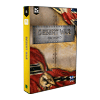DESERT WAR: SHOCK EXPLAINED
“Everyone was talking and chatting, when slowly came into sight the first tank I ever saw. Not a monster but a very graceful machine with beautiful lines…. Here was the missing tool of penetration, the answer to the dominance on the battlefield of small-arms fire.”—J.F.C. Fuller
Matrix Games/Slitherine’s upcoming release of Brian Kelly’s Desert War 1940-42 uses a simple game mechanic often found in WWII board games. It gives tank units a “special place” in the player’s toolbox—a positive shift to the combat force ratio if attacking, and the opposite when defending. Coming up short of attack factors? No problem! Throw in some tanks. A 1 to 1 attack can become a 2 to 1, 3 to 1, 4 to 1, etc. In Desert War 1940
Shock
So…how did armored forces create this “shock” effect during the early stages of WWII? Simply put, they employed speed, unexpected directions of attack (especially from the flank and rear), and overwhelming firepower at the decisive point to destroy (kill, capture, or cause to cower) units within the enemy’s command--which in turn reduced, eliminated, or frustrated the options available to the enemy commander.
How did we model it in Desert War 1940-42? In three ways. Successful mechanized force commanders employ three key ingredients to achieve victory on the battlefield—rapid mobility, overwhelming firepower, and shock/surprise. Desert War strives to replicate these ingredients and their interactions in game play.



 Cart (0)
Cart (0)
